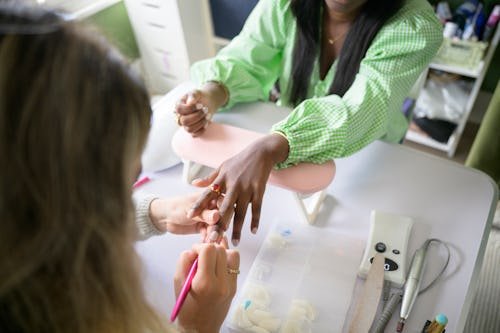

Bill Hader is always a delight, so when TikTok served me a video of him on Late Night with Seth Meyers, I gleefully let it play. In it, Seth asked him about his recent bout of shingles, an infection characterized by a painful rash and caused by the same virus that also brings us chickenpox. It typically occurs in people age 50 and older, which I happen to know Bill is not, and then Seth asked my question: How did that happen? It was his anxiety, Hader said, explaining funnily how his doctor delivered the news that stress can, in fact, cause shingles. I was a little stunned and had to watch it again, because it was the first time I’d ever heard of anyone experiencing what happened to me.
I developed shingles at the ripe old age of 22, after an international trip caused my anxiety to skyrocket and I couldn’t stop the flow of panic attacks (I know, boohoo poor little globetrotter, I said it to myself plenty). I booked an early flight home, and the very next day, a strange red rash appeared on my left side. When I went to urgent care, the doctor shook his head and told me it was both “impressive and disturbing” how powerful our minds can be, and that my anxiety must have suppressed my immune system so thoroughly that the shingles virus could take hold.
It wasn’t until this random but welcome clip of Hader talking about the anxiety-to-shingles pipeline that I’d heard of anyone else who had experienced it. Turns out my urgent care doctor was right on the money. And because we’re all kind of stuck in fight-or-flight right now, is this something that’s going to start happening more?
Can anxiety cause shingles?
In short, doctors think so, but the relationship between the two is still not well defined. For starters, here’s how shingles works.
“Shingles is the same virus as chickenpox — we all get chickenpox when we’re young, or we’ve had the shot, but the reality is that it never goes away. It lies dormant in our neural cells, in our nerve endings, and then it can reactivate,” Dr. Suraj Saggar, chief of infectious disease at Holy Name Medical Center. The virus is typically kept in check by the immune system, which can weaken as we age (hence why the shingles vaccine is recommended for those 50 and older) or can be suppressed by other health conditions.
Conditions like lupus, rheumatoid arthritis, cancer, or immune-suppressing medications are all associated with an increased risk of shingles, Saggar says. He then points out that Hader has spoken publicly about having an autoimmune condition, which could have made him more vulnerable to the shingles virus reactivating. As for anxiety causing shingles, there isn’t great scientific evidence of that yet.
Several studies have attempted to define the link between extreme stress and shingles, but the results have been “somewhat all over the place,” Saggar says. “Some early studies show that men with high mental stress were twice as likely to get herpes zoster. But the reality is that some studies have shown it and some studies haven’t. So I can’t say for sure as a physician that increased anxiety or other mental stresses definitively increase your risk for shingles.”
That said, Saggar has seen shingles in people who are young and under significant stress — he gives the example of a college student who wasn’t sleeping enough during exams — and who have no other risk factors for developing shingles. To him, it stands to reason that the body’s fight-or-flight response would suppress the immune system, “and so it’s not surprising that when you have prolonged stress, you can perhaps increase the risk of shingles if your immune system goes down.”
Of course, managing your stress and anxiety is really the only method of prevention here. If, like me and my good friend Bill, you’ve contracted shingles before, you can talk to your doctor about getting the vaccine before age 50.
Symptoms of shingles
As Hader so eloquently put it when talking to Meyers, shingles needs a harsher name, more like “fire blisters.” The symptoms were more intense than he expected, including a backache and “blisters that feel like they have ants inside of them crawling out of your skin,” Hader said.
Symptoms typically begin with nerve pain — to me, I wondered if I’d somehow pulled some muscles in my back and then my side. Within days, a rash will appear over those areas. The rash typically “stops at the midline,” Saggar says. Because shingles follows the nerves, the pain and rash travel out from the spine and around to your front, but that’s where the nerves end, so the rash won’t cross over the center of your body. The rash is red and forms little blisters that crust over and heal within one to two weeks, he says. You may also experience headache, fever, and blurred vision, if the rash extends to your face.
Unfortunately, after the rash goes away, some people are left with postherpetic neuralgia, painful irritation of the nerves, for up to a year after the infection, Saggar says. So, if you are someone at risk of developing shingles, there’s a little extra incentive to get the vaccine.
While anxiety-induced shingles isn’t necessarily common, perhaps Hader’s candid convo about it will bring it into more people’s awareness, and renew interest in figuring out exactly how that brain-body connection really works.


